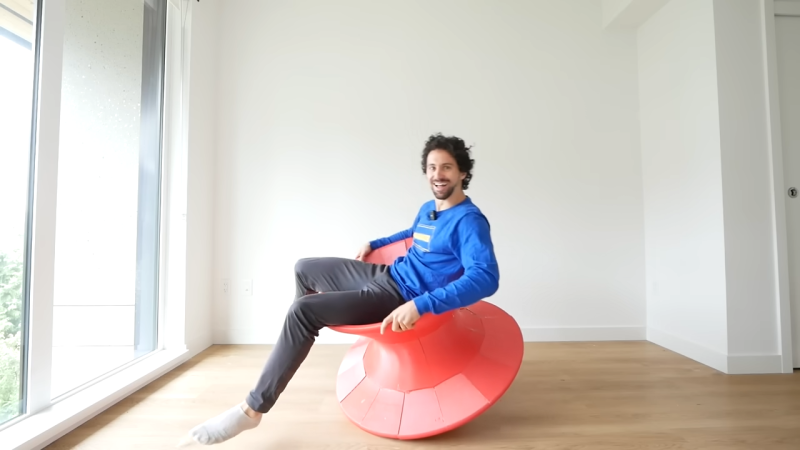The Magis Spun chair is a weird piece. It’s basically a kind of seat with a round conical base that stops it from sitting still in one place. Instead, it rolls and pivots around when you sit on it, which is apparently quite fun. They’re expensive though, which gave [Morley Kert] a neat idea. Why not 3D print one instead?
Obviously 3D printing a sofa wouldn’t be straightforward, but the Magis Spun is pretty much just a hunk of plastic anyway. The real thing is made with rotational molding. [Morley] suspected he could make one for less than the retail price with 3D printing.
With no leads on a big printer, he decided to go with a segmented design. He whipped up his basic 3D model through screenshots from the manufacturer’s website and measurements of a display model in a store. After print farming the production, the assembly task was the next big challenge. If you’re interested in doing big prints with small printers, this video is a great way to explore the perils of this idea.
Ultimately, if you want to print one of these yourself, it’s a big undertaking. It took 30-50 print days, or around 5 days spread across 15 printers at Slant 3D’s print farm. It used around $300-400 of material at retail prices, plus some extra for the epoxy and foam used to assemble it.
The finished product was killer, though, even if it looks a little rough around the edges. It rolls and pivots just like the real thing.
We don’t feature a lot of chair hacks on Hackaday, but we do feature some! Video after the break.
















Lovely build. Silly product, silly project, lessons to learn, fun video.
There’s something very satisfying about taking a pretentious, overpriced item and reproducing it for a fraction of the price.
Now make Vantablack.
600 bucks is still a bit posh if you ask me. There is however the opportunity to build chairs out of stacked cardboard, so here’s that recycling challenge to make one for 1 € / USD / you name it based on cardboard waste and starch glue.
Using the amount of plastic for the build in the video, and then contaminating it with epoxy so it cannot be recycled later, is a bit meh.
Love the cardboard/glue idea. Or if you have a foamcutter and fiberglass…maybe kevlar?
stacked cardboard cut on a CNC laser, would need something ridged on the outside like fiberglass or a few rings/layers made of wood at key locations.
An interesting proposal.
There’s a company with a homebrew kind-of vantablack:
https://www.culturehustleusa.com/products/black-4-0
They caveat that you are not allowed to buy it if you are Anish Kapoor.
The story of those two is hilarious. Anish seems like a bad person to me, but the story is really funny. Anish bought that vantablack for example to prevent others from using it.
https://www.thecollector.com/vantablack-anish-kapoor-stuart-semple-controversy/
They’re both odd ducks who have made some poor (imo) choices. Vantablack wasn’t even usable like a traditional paint, so I’m just glad that this led people to develop other paints (black series, the pinkest pink, etc)
The whole ‘story’ is basically entirely made up to create this narrative that Semple is some kind of underdog hero. So many of the basic facts are wrong. Kapoor did not ‘buy’ vantablack, he is not preventing other artists from using it, and in fact other artists have used it. But it’s also not a paint. It’s a nanotube structure that has to be made in a lab by one company. The company that makes it normally manufactures things with it for the defense and science industries, but a few times have decided to partner with artists including Kapoor. The reason it isn’t ‘available’ to the public is that it costs a fortune. If you went to Surrey Nanosystems today with, say, 50 million dollars they’d manufacture whatever you want covered in vantablack.
Looks like a head injury.
Everything worthwhile carries with it the risk of some brain damage.. You have to look at it with a somewhat French attitude
Le french-fried attitude, c’est vraiment!
Rolling your own X is always a good decision, but doing it like this, I dunno. There are a ton of clever / thrifty / sustainable ways you could make this object, or you could just ignore all that and pay someone hundreds of dollars. I’m guessing 99% of people here would back option 1, and might feel like this verges on stolen valor.
(My immediate thought was how I once talked to an old theater props guy about how they’d use plywood profiles to lathe big chunks of PS foam into Doric columns and stuff. Then in this case you’d use Modroc -> fiberglass etc)
yea I was thinking between your comment and the one above about stacked cardboard, that stacked cardboard + angle grinder (bought mine at goodwill for 5 bucks), some form of carving disk, and some form of shell one could knock this out in a couple days for like 100 bucks if having to buy the tools and shell material (cardboard is free)
of course Im not going to bother with it, but it was a fun thought exercise
I, too, am familiar with the effort to get something for cheap and still end up spending a bunch of money on a fairly shoddy home-made version of it. It can still be fun (and very youtubeable!)
You could probably print it in one piece with a https://www.elegoo.com/products/orangestorm-giga
You didn’t watch the video did you.
Nope!
No cries of “Waste Plastic!” or “Dumb Project”?
No “I’ve blocked the channel” claims?
Why not?
Amazon has knockoff for $326.
Sat on one of these at a conference a while back… it was surprisingly comfy for a tall person with a back injury. then I got home and priced them, bought a lazy boy and a GPU instead.